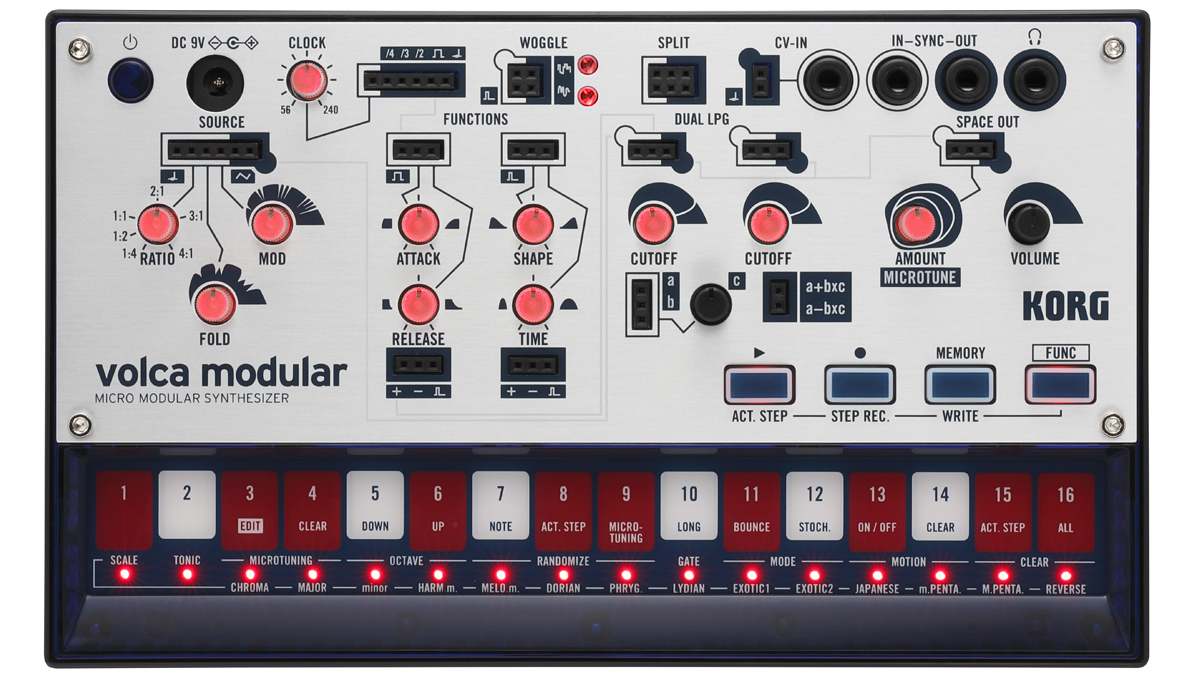NAMM 2019: Korg’s Volca Modular synth looks like a portable patching powerhouse
The company goes West Coast with its pint-sized pin cable instrument
NAMM 2019: It might be small, but it looks like there’s a fair bit of synth inside Korg’s new Volca Modular. In fact, it’s a proper semi-modular synth that offers analogue synth modules, digital effects and a seqeuncer.
Let’s get to those all-important modules first, which are internally routed so that you can get sound out of the synth without even touching any of the tiny patch cables (the routing is shown on the front panel). However, once you start plugging things in, your connections take priority over the internal ones.
There are a total of eight modules included, described by Korg as follows:
- SOURCE: This consists of a triangle VCO carrier and a modulator. The complex overtones generated by FM modulation are sent through a wave folder circuit to add additional overtones, producing a distinctive sound. This module is important in determining the basic character of the sound of volca modular.
- FUNCTIONS: This section consists of two function (envelope) generators. In addition to an ADH generator with attack, hold, and release, there's a Rise-Fall generator, also known as a slope generator, which not only applies time-varying change to the sound but also lets you patch the end trigger out back into the trigger in as a loop, making it usable as a VCO or LFO.
- WOGGLE: This is a random signal generator containing a sample & hold circuit that uses pink noise as its source. Two outputs are provided, allowing it to output either stepped or smooth random noise.
- SPLIT: This module distributes one input to two outputs. It can also be used in the reverse direction, combining two control or audio signals into one.
- DUAL LPG: This consists of two low-pass gate circuits. Typical of the West Coast style of synthesis, the module packages a filter with an amp, allowing the brightness and volume of the sound to vary together.
- UTILITY: This is a mixing scaling module that combines two signals in various ways. It can mix not only audio signals but also control signals, as well as inverting or attenuating those signals.
- SPACE OUT: This is a stereo module that applies a reverb-like effect to the audio signal.
- SEQUENCE: This module is for connecting to the internal sequencer. You can set the tempo, and select different rhythm divisions to output via the gate counter.

The Volca Modular is in the West Coast synthesis style, and enables you to produce all kinds of different sounds. There are 50 patch points, with inputs and outputs colour-coded for your at-a-glance reference.
In true Volca style, there’s a 16-step sequencer. You can use its buttons for step input or play them like a keyboard and record in realtime. Motion sequencing means that you can record knob movements, and there are active step and randomise options. There are also a couple of new sequencing modes: bounce takes a round-trip through the steps, while stochastic gradually proceeds with random moves back and forward, opening up fresh creative opportunities.
The Volca Modular supports 14 types of scale, including equal temperament, while a microtuning option lets you individually specify the pitch of each note. Connectivity options include a sync jack, so that you can hook the synth up to other Korg instruments, and CV In on a TRS mini jack that allows for input of two signals.
With its compact size, battery power option and built-in speaker, the Volca Modular really is a patchable synth that you can take anywhere. Korg says that it’s designed to make analogue synthesis more accessible and understandable than ever before, so we’re keen to discover if this little instrument lives up to its billing.
Want all the hottest music and gear news, reviews, deals, features and more, direct to your inbox? Sign up here.
The Volca Modular will be released this month at an as-yet undisclosed price. Find out more on the Korg website.
––––––––––––––––––––––––––
NAMM 2019 - all the news
The dust is settling, but our ears are still ringing. You'll find all the stories that counted in our massive news hub. Below, enjoy our findings as we regrouped at the end of the show.

I’m the Deputy Editor of MusicRadar, having worked on the site since its launch in 2007. I previously spent eight years working on our sister magazine, Computer Music. I’ve been playing the piano, gigging in bands and failing to finish tracks at home for more than 30 years, 24 of which I’ve also spent writing about music and the ever-changing technology used to make it.